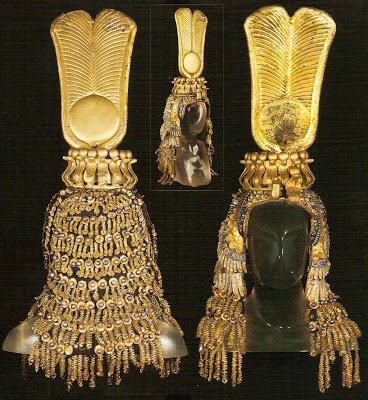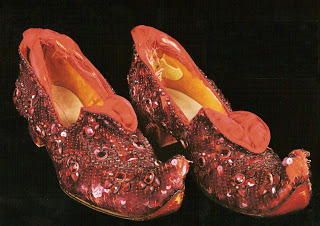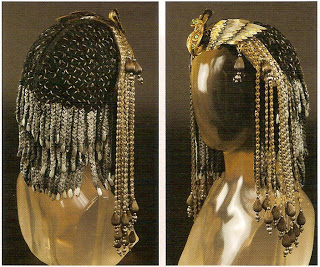The Museum That Never Was, Part 1
When I bought the catalog for the Debbie Reynolds Auction from the Profiles in History auction house, I admit it was with the thought that I just might be able to get down to L.A. for the event itself on June 18. Well, family plans closer to home made that idea a non-starter, but there was still the possibility that I might be able to bid on something by phone or on line. Then a 16mm print came up for auction on eBay that I set my cap for, and it wound up costing more than I expected, though less than I was willing to pay. (Not that you asked, but it’s a kinescope of a 1956 live TV dramatization of Jim Bishop’s The Day Lincoln Was Shot starring Raymond Massey, Lillian Gish and Jack Lemmon.)
So what with one thing and another, my hopes of getting to the auction or of taking home anything from it were not to be.


other hand, if you were daunted by the
$30,000 opening bid, or by the headdress’s
fragile condition…
I’m not sure what Debbie’s vision for her museum was; myself, I’d have loved to see something like the Gene Autry Western Heritage Museum — now known as the Autry National Center — in Griffith Park. (And by the way, if you thought a “Gene Autry Museum” would amount to little more than a collection of Gene’s old guitars and posters from his movies, think again. It’s a world-class facility honoring every facet of America’s western heritage, and belongs at the top of your must-see list if you’re ever in Los Angeles.) Whatever Debbie’s ideas were, they’ve come to naught, while she’s spent half her life (and apparently all her money) acquiring and properly storing and maintaining umpteen thousand pieces of Hollywood history — and trying to find a home for them.
Frankly, if I were Debbie Reynolds, I’d be mad enough to bite the bumper off a truck. In an interview about the auction with Idaho TV station KIDK, she said, with an air of philosophical resignation, “I’m a fan of all of these great stars and I wanted to save their moment for a museum for the future. I didn’t reach that goal, which makes me sad, but these things will be shared with people that love the stars as much as I do.” In another interview she sounded a little more like I’d probably feel (i.e., testier): “I am really sick and tired of it. I feel that I must call it a day now. Over the years, I have literally spent millions of dollars protecting it and taking care of it. If you were me, wouldn’t you give up after 35 years? There is no other road. I need a little rest from the responsibility of trying to do something it seems that nobody else wants to do. Hopefully everyone will have a good time with their piece.”
All those years haven’t completely gone to waste. The day-to-day operations of Golden Age Hollywood are as over and done as the haggling in an Etruscan marketplace. We may still have the movies — and that ain’t exactly nothin’ — but it won’t do to lose sight of the nuts and bolts that went into building them. Being able to see and study these artifacts (like this gown Debbie wore as she crooned “A Home in the Meadow” in How the West Was Won) gives them a real-world texture and solidity that the movies alone, even HTWWW in all its 7-channel Cinerama glory, could never do.
Without Debbie Reynolds, the items in her collection — Charlie Chaplin’s derby, Basil Rathbone’s Sherlock Holmes Inverness cape, Audrey Hepburn’s black-and-white Ascot dress (and Rex Harrison’s clash-matching brown suit), Barbra Streisand’s entire Funny Girl wardrobe, the kids’ drapery outfits and Julie Andrews’s guitar from The Sound of Music, Elizabeth Taylor’s Cleopatra sedan chair, palace decorations and Yul Brynner’s whip from The King and I, Bette Davis’s throne from The Virgin Queen, Empress Josephine’s royal bed from Desiree, Clifton Webb’s Boy Scout uniform from Mr. Scoutmaster, Howard Keel’s rifle from Annie Get Your Gun (or Clark Gable’s from Mogambo), the 20-foot miniature warships from The Winds of War, the Ark of the Covenant from David and Bathsheba — all might well be long-moldering somewhere in Los Angeles County’s bulging landfills. As frustrated and disappointed as Debbie might be, she can claim victory in (and we can thank her for) having shepherded all these things past the point where they were simply junk.








Kevin, Dorian, thanks both. It is mystifying, isn't it, how Debbie has had to face so many obstacles in this. Seems to me the proceeds from a single weekend of a Transformers or Pirates of the Caribbean movie would be enough to build a museum that would be one of the wonders of the world. Ah well.
Dorian, as I'll be saying in Part 2, at least these exhibits aren't literally "lost to the ages." But they are lost to the public — so your "all but" qualifier is exactly right.
Wow, Jim, I'm floored that all the beautiful, amazing artifacts and memorabilia in Debbie Reynolds' "Museum that Never Was (Part 1)" can't find a home, or at least go on tour with all these wonderful things. This collection belongs in the Smithsonian or The Metropolitan Museum of Art, or perhaps go on tour like the King Tut exhibition! These remarkable items don't deserve to be all but lost to the ages. If Princess Diana's memorabilia could get a record-breaking tour, why not Debbie Reynolds' items? Where's a winning multi-million-dollar lottery ticket when you need one, so we fans could build such a museum ourselves? I look forward to Part Two of this fabulous yet poignant post, Jim!
Also, Jim, while I have your attention, thanks a million for including my blog TALES OF THE EASILY DISTRACTED among your favorites in your own wonderful blog! My dear hubby and frequent co-blogger Vinnie thanks you, too!
Wonderful article, Jim, if not more than a bit sad. Hollywood is known for not celebrating its past like they should, and the fact that Debbie Reynolds could not find a home for her treasure trove is heart wrenching.
I remember the first time I visited Hollywood in the early 1990s how disappointed I was that the city fathers did not seem fit to capitalize on the glamour of Hollywood. Of course, Hollywood is not what it was back in the early days, but millions of people from around the world flock there every year and its depressing that some smart planners have not done more to capitalize on that.
Its too bad the new Kodak Theater could not find room for a Hollywood History Museum. It seems like a natural idea and one that should have been done years ago.
Even a few blocks around the area of Grauman's, the Egyptian and the Roosevelt Hotel could have been transformed into something special. After all, who knows more about illusions than Hollywood? I guess anywhere but their own backyard.
Looking forward to Part Two.